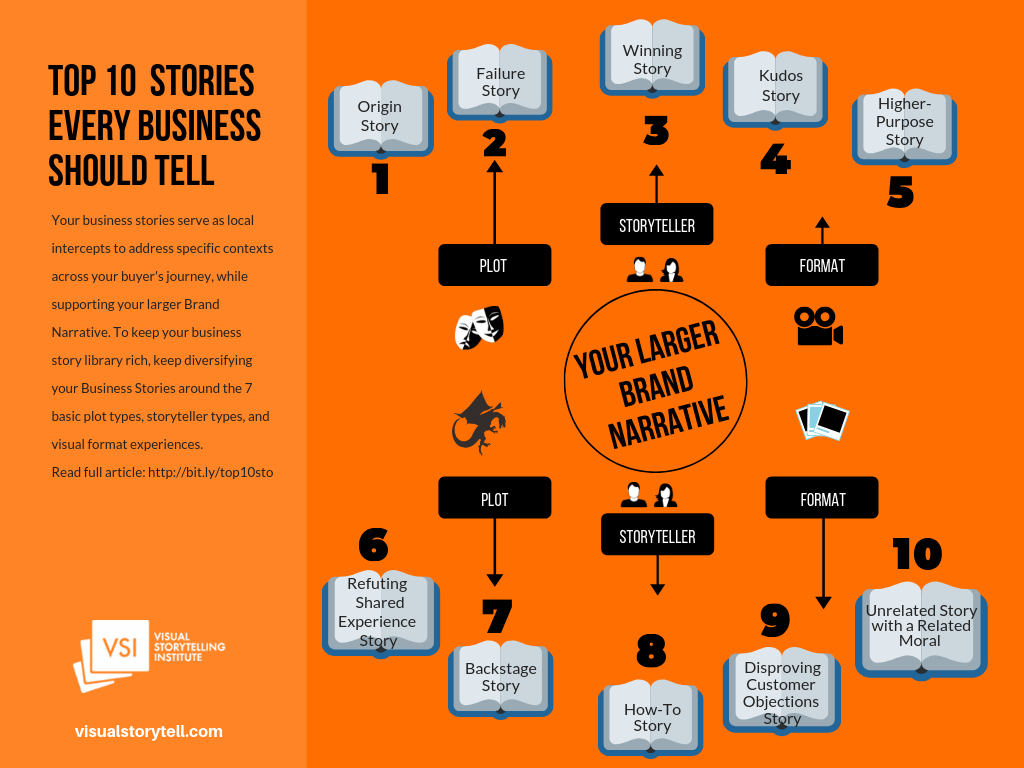
Top 10 Stories Every Business Should Tell
Top 10 Stories Every Business Should Tell https://www.visualstorytell.com/wp-content/uploads/2019/08/bstories_thumb.png 366 218 Shlomi Ron Shlomi Ron https://secure.gravatar.com/avatar/995c0cf093380b90c7704fda398c9addf4e5c605afbc92af5c3f01f67d65aa41?s=96&d=mm&r=g
What types of stories are you telling as part of your overall visual storytelling strategy?
I often receive questions from clients and students after working hard to nail down their unique Brand Narrative statement, they ask “Now what?”
As you may know, a Brand Narrative is only the beginning. It’s like deciding on the style of your house; Victorian, Cape Cod, Tudor or Ranch. Next, you need to develop the actual “rooms” in the house style you chose. In our case, these are the Business Stories that support your overall Brand Narrative.
In essence, a Brand Narrative is that succinct elevator pitch statement, designed to wow your audience with a powerful why they should care about solving that burning problem, a touch of your solution, a sprinkle of your credibility, a meaningful reward that will finally spring them into action.
I have already written about the difference between a Brand Narrative and Business Stories. In short, “Your Business Stories serve as proof points that support your larger Business Narrative with showing vs. telling your What and How. As such, stories follow the three-act story structure (i.e., Setting, Conflict, and Resolution).”
In this post, I’d like to lay out the top 10 business stories you must tell as part of your visual storytelling strategy.
Before we jump right in, I should say that any business story I outline here could be diversified by plot type, and storyteller type:

- 7 Basic Story Archetypes: Traditionally, any story that was ever told, falls under these 7 plot types: Overcoming the Monster, Rebirth, Quest, Journey, and Return, Rags to Riches, Tragedy, and Comedy. You can see how these plot types are applied in advertising. But in this post, my focus is more about long-lasting business stories than short-term ads.
- Storyteller types: The brand’s marketing team, non-marketing employees, customers, partners, vendors, media, and third-party. Each one of these storytellers could tell a unique business story that can support your larger brand narrative.
So, here we go with the top 10 business stories you must tell:
1. Origin Story
Your origin story tells your backstory. What made you start your business? Reflect on what you’ve done before you started your business, what inspiration lightning struck you to set you on your journey (i.e., Initial Incidence)? What was your first action to solve the problem? What challenges did you encounter? What emotional victory did you have with your first customer?
Usage: Origin stories are best kept on your Website in what used to be called About Us section that these days has morphed into Our Story. Summarized versions could also work in presentations. If you have images or videos from your early days that’s the perfect place to plug them into your origin story and this way bring to life your journey. People value more brands that have a meaningful origin story.
2. Failure Story
Regardless of the storyteller I outlined above, people look for what I call “real stories by real people.” That means acknowledging the mere fact that life is never perfect and anyone often faces some weakness or vulnerability. Customers interpret this kind of stories as evidence for the brand’s authenticity and humanity. This kind of transparency such as confessing to a poorly received talk or a lost pitch, coupled with a meaningful moral, helps build that sought after customer trust.
Usage: Failure stories because of their radical perspective can help you drive awareness at the top of your funnel or at mid-funnel to educate customers. Possible uses could include Instagram visual stories, Facebook videos, LinkedIn employee’s short vignettes. If you come up with a catchy hashtag you can even include your audience to celebrate their failures and learnings and turns this into a lively User-Generated-Content play.
3. Winning Story
The reality is that most stories you encounter on social these days could be considered as “brag stories.” From new business win, high-profile talk, new hiring requests, new partnerships, award wins, and many more. This is how advertising and marketing were done for eons with the sole purpose of representing the brand in the most positive way.
Usage: With the ingrained dominance of winning stories on social and elsewhere, you need to tread carefully here. Pick a few winning stories that go beyond your immediate business reward and elevate the story with a higher purpose reward (see Higher-Purpose Stories below) that makes a difference in your community. If you could tie the benefactors from your higher-purpose activity to contribute to the story, your brand trust will further increase.
4. Kudos Story
We can never recognize enough other people who contribute to our business success. Showing gratitude for others helps paint your business and employees as team players who support and care for one another. It’s a great signal for your prospects who are still under the consideration stage, for your customers as it validates their decision for working with you, for potential partners, for media coverage and lastly – for potential employees that may consider joining your team.
Usage: The act of selfless giving rewards not only the giver but also the recipient, who will do the utmost to broadly share her unexpected kudos. Since we talk about visual storytelling, the kudos giver could experiment with a variety of visual formats; from a screengrab of a hand-written Thank You note, Instagram images, personal or video Thank You. At the highest involvement levels, a kudos recipient will go beyond flat-sharing and post a standalone counter Thank You note to the giver which will extend the impact of the original kudos story.
5. Higher-Purpose Story
Higher-purpose means being engaged in an activity that carries a larger reward beyond personal or economical gains. This kind of selfless reward makes a difference in your neighborhood, city, country and the world. Higher-purpose stories signal to your audience that your brand is associated not only with making money but with making the world better.
Usage: These kind of stories often fall under Cause Marketing programs that benefit a collective (e.g., green programs, cause-related walks, labor contributions to a community, etc), but not always. Sometimes, it could be a story about singling out a specific individual in need and having the brand help in a big way. A few years back these programs used to be called Random Acts of Kindness. These days, I think they should evolve into Routine Acts of Kindness Higher-purpose stories. They work well at the top and mid-funnel, as they light a positive and unselfish perspective about your brand. Visually, it works well when you are able to communicate the experience as a series of documentary videos or images. This allows your audience to follow the program progress and celebrate once it arrives to its conclusion.
6. Refuting A Shared Experience Story
The magic of this story type is by leveraging the high popularity of a shared experience of your target audience.
This story comes in two flavors:
a) Refuting An Accepted Norm: As you may know, every group of people operates under shared beliefs and norms that work as shortcuts to make decisions.
b) Refuting A Real-Time Shared Experience: This kind of story is also referred to as Newsjacking , where a brand leverages a timely experience and provides a fresh perspective on how to address it.
Usage: A Refuting An Accepted Norm story could work in a variety of industries. Take, for example, us marketers that largely adopted the Buyer’s Journey as a common conceptual framework to analyze customer experience. A refuting story could be The End of the Buyer’s Journey—Why Story Is the Better Metaphor for Marketers. By breaking a common norm in your industry, your refuting story will gain broader awareness and interest.
The iconic example of Refuting A Real-Time Shared Experience is naturally the 2013’s Oreo campaign during Super Bowl XLVII. A 34-minute unexpected power outage opened a cultural opportunity for the brand’s social team who sprung into action and updated their storytelling strategy with a clever tweet that mirrored the shared experience of their audience: “Power Out? No problem” with a lit image of a single Oreo and the caption, “You can still dunk in the dark.”
Both refuting stories offer a wide range for visual storytelling expression; from a visual blog post, visual tweet, data-driven infographics, or video story. This kind of story is getting richer as you also diversify the storyteller; for example, a brand’s perspective vs. a customer perspective.
7. Backstage Story
I have recently written about Backstage Stories. This type of story allows any storyteller type from the above list, a unique perspective to share with your audience the rough and unedited journey Behind-the-Scenes. As such this kind of storytelling helps to humanize your Brand Narrative as it exposes human challenges, doubts, and failures associated with a product development process or any worth sharing business-related activity that touches your business.
Usage: Backstage stories are highly visual as they allow you to share non-professional images and videos in a delayed or real-time mode with your audience. For this story type to work, total honesty and keeping awkward glitches in – is key.
8. How-To Story
As their names suggest, these stories teach your audience how to use or overcome challenges using your product or service. The more technical your product is, the more it would lend itself better for a How-To story.
Usage: The hallmark of How-To stories is by far on YouTube, covering any imaginable topic. Another good place for How-To stories is owned media like your Support section on your Website, support mailing list, or blog. Stories could range from video, image slideshow to infographics, as well as by the unique perspective of the storyteller.
9. Disproving Customer Objections Story
After you closely research your ideal customer persona, you’ll most likely find what are their key objections at each stage of the buyer’s journey. This is critical as your audience information needs to constantly change from being a prospect, to being a customer and then advocate. You can learn more on my recent post: How to Maximize Your Story’s Impact by Celebrating Your Customer Objections. These kind of stories allows you to preempt the most common objections your audience voices, and offer timely rationale as to what is the proper way to address, and this way proactively manage your brand experience.
Usage: You should bake these kind of stories at each stage of your buyer’s journey as they would help deflect any customer objections. This way, they will help move your audience down your sales funnel. Visually, objection stories could be part of real-life video stories customers shared with you, real-time dialogs on visual chatbots, sales pitches, or high-profile talks.
10. Unrelated Story with a Related Moral
All the above stories largely come directly from stakeholders in your business sphere. Whereas Unrelated Stories cover unrelated business topics. They could be a newspaper article you came across, a movie, a book, an unrelated personal story that happened to you or someone you know. They are effective because they offer a soft entry point to engage your audience with a compelling story before revealing a related business moral. In this area, you’ll find the nascent StorySelling approach that leverages our human propensity to connect better with information that is packaged as stories – to drive sales.
Usage: Unrelated Stories could be used in a variety of ways. For example, I used an episode from the Black Mirror TV series to underscore a point. I also often use personal stories that happened to me – from a flat tire, baking bread, to a taxi ride. These ordinary stories are easy to relate to and carry some of the key human attributes I’ve already discussed like vulnerability, failure, and doubts – that work to build trust. The key is to pick a single aspect from the Unrelated Story and blow it up as part of your business-related moral. This technique works well in StorySelling during sales pitches, as part of ongoing email communication, blogs, Vlogs or podcasts.

As you can see, business stories, in essence, serve as local intercepts to address specific contexts across your buyer’s journey, while supporting your larger Brand Narrative. To keep your business story library rich, keep diversifying your Business Stories around the 7 basic plot types, storyteller types, and visual format experiences.
What kind of business stories are you creating in support of your larger Brand Narrative?
Need help setting up your Visual Storytelling strategy with the right Business Stories? Feel free to call me 305-985-3450 or email me shlomi_at_visualstorytell_dot_com
Shlomi Ron
Shlomi Ron is the founder and CEO of the Visual Storytelling Institute, a Miami-based think tank with a mission to bring the gospel of visual storytelling from the world of art to more human-centric and purpose-driven marketing. A digital marketing veteran with over 20 years of experience working both on the agency and brand sides for Fortune 100/500 brands such as Nokia, IBM, and American Express. He started VSI to combine his marketing expertise with his passion for visual stories stemming from his interests in classic Italian cinema and managing the estate of video art pioneer, Buky Schwartz. At VSI, he helps brands rise above the communication noise through visual storytelling consulting, training, and thought leadership. Select clients include Estée Lauder, Microsoft, and Cable & Wireless – to name a few. He currently teaches Brand Storytelling at the University of Miami’s Business School. Thought leader and speaker at key marketing conferences. He is also the host of the Visual Storytelling Today podcast, which ranks in the top 10 best business storytelling podcasts on the Web. His book: Total Acuity: Tales with Marketing Morals to Help You Create Richer Visual Brand Stories. Outside work, he is a nascent bread baker, The Moth fan, and longtime fedora wearer likely to jive with his classic Italian cinema interest.
All stories by: Shlomi RonYou might also like
4 comments
This site uses Akismet to reduce spam. Learn how your comment data is processed.



Leave a Reply